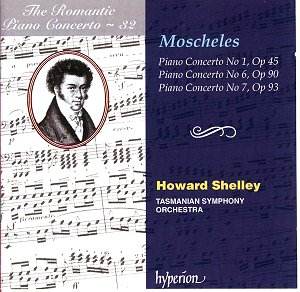The Moscheles of the 1818 concerto instantly
announces himself as a Mozart disciple. The style is best likened
to the Mozart of concertos 20, 23, 24, 25 and 26. Moscheles laces
the perfection of elegance and regret with cheeky spirited confidence
as in the Rondo finale of the first concerto. Twenty years
later in the other two concertos the ebullience and gentle ardour
have moved very close to Schumann. However there is something
distinctively personal in the magically unpredictable and elusive
andante as well as in the tempestuous allegro and vivace of the
Fantastique. There are some brilliantly effective musical
gestures such as the solo line from 00.53-1.38 in the vivace finale.
The same can be said of the first movement of the overcast first
movement of the Pathétique which is Bohemian and
storm-pent. This style is familiar from Mendelssohn as in the
Ruy Blas or Fair Melusine overtures. After a skittish
allegro agitato comes an allegro con brio which is touched with
the grace phrases we expect from early Beethoven.
Prague born, this pupil of Albrechstberger and
Salieri rubbed shoulders with Hummel and Beethoven. He spent twenty
one years in London, taught Mendelssohn in Berlin, and ultimately
spent many years as professor of the piano in the Leipzig Conservatory.
Moscheles prepared the piano reduction of Beethoven's Fidelio.
These are by no means the ‘glitter and surface’
affairs you might have expected. This is supremely fashioned entertainment
with a touch of pathos along the way. They will appeal to lovers
of the concertos by Mendelssohn, Schumann and Beethoven.
Vintage romantic piano concertos leaning on Mozart
as an exemplar in the case of the First and Schumann and Mendelssohn
for numbers 6 and 7. These are freshly performed and directed
by Howard Shelley and well documented by Henry Roche. No need
for Hyperion to do anything other than hold their heads high over
this one.
Rob Barnett
